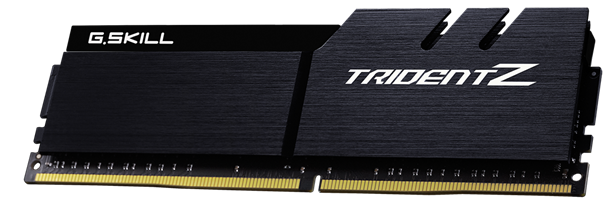G.Skill Announces Quad-Channel DDR4-4200 Kit for Intel Skylake-X CPUs
by Anton Shilov on June 29, 2017 2:00 PM EST
G.Skill this past week has formally announced its quad-channel memory kits designed for the latest Intel Core i7 (Skylake-X) CPUs and the Intel X299 platform. The flagship 64 GB Trident Z kit boasts a 4200 MT/s data transfer rate, a rather notable step up from the company's "entry-level" 3600 MT/s kit. In addition, G.Skill is also introducing its new Trident Z Black series dual-channel DDR4-4400 kit for Intel’s Kaby Lake-X processors.
G.Skill’s lineup of memory kits for the Intel X299 platform consists of 8 GB and 16 GB Trident and Trident Z RGB DIMMs based on Samsung’s popular 20nm-fabbed 8 Gb DDR4 DRAM modules. The various kits are available at 3600 MT/s, 3733 MT/s, 3800 MT/s, 4000 MT/s, and 4200 MT/s data transfer rates, while their voltages run from 1.35 to 1.4 V. As you'd expect, the higher clocked kits also come with higher latency, with latencies starting at CL16 and reaching CL19 by DDR4-4200 speeds. Which goes to show that even though Intel's Skylake-X and Kaby Lake-X CPUs can handle very high DRAM frequencies, the tradeoff between clocks and timings has not gone anywhere.
Meanwhile it's interesting to note that despite G.Skill's recent obsession with RGB lighting – resulting in the company offering RGB-equipped DIMMs for most of the Trident Z range – the fastest DDR4-4200 and DDR4-4400 kits are not available with RGB lighting. Keeping in mind that this kind of extreme DDR4 overclocking requires increased voltage and very “clean” power, it may not be easy to apply RGB to such DIMMs without affecting their stability. Still, keeping in mind that G.Skill itself demonstrated DDR4-4200 Trident Z RGB DIMMs in quad-channel mode at Computex, it is a matter of time before appropriate modules will hit the market.
| G.Skill's Trident Z Memory for Intel's X299 Platform | |||||||
| Speed | CL Timing | Voltage | Kit Configuration | Kit Capacity | Family | ||
| DDR4-3600 | CL16 16-16-36 | 1.35 V | 4×8 GB 8×8 GB |
32 GB 64 GB |
Trident Z Trident Z RGB |
||
| CL17 19-19-39 | 4×16 GB 8×16 GB |
64 GB 128 GB |
|||||
| DDR4-3733 | CL17 17-17-37 | 4×8 GB 8×8 GB |
32 GB 64 GB |
||||
| CL18 19-19-39 | 4×16 GB 8×16 GB |
64 GB 128 GB |
|||||
| DDR4-3800 | CL18 18-18-38 | 4×8 GB 8×8 GB |
32 GB 64 GB |
||||
| CL19 19-19-39 | 4×16 GB 8×16 GB |
64 GB 128 GB |
|||||
| DDR4-4000 | CL18 19-19-39 | 4×8 GB 8×8 GB |
32 GB 64 GB |
||||
| DDR4-4200 | CL19 19-19-39 | 1.4 V | 8×8 GB | 64 GB | Trident Z | ||
| DDR4-4400 | CL19 19-19-39 | 1.4 V (?) | 2×8 GB | 16 GB | Trident Z Black | ||
G.Skill traditionally announces its new memory modules a little bit ahead of their retail launch and does not set MSRPs ahead of actual availability, so pricing has not yet been disclosed on the company's newest kits.
Related Reading:
- DRAM and Motherboard Makers Demonstrate Quad-Channel DDR4-4000+ Operation
- G.Skill Announces 16 GB DDR4-4333 Memory Kit for Intel Kaby Lake CPUs
- G.Skill Announces Trident Z RGB DDR4 Kits with 16 GB Modules, Up to 128 GB
- AMD Announces Ryzen AGESA 1.0.0.6 Update: Enables Memory Clocks Up To DDR4-4000
- Corsair Vengeance RGB DDR4 Memory Modules with LEDs Now on Sale
Source: G.Skill











11 Comments
View All Comments
willis936 - Thursday, June 29, 2017 - link
And it will only be 60% of your high end CPU build cost.willis936 - Thursday, June 29, 2017 - link
Actually that 3600-16 kit has some impressively low latency for what will hopefully be the cheapest kit in this lineup.FwFred - Thursday, June 29, 2017 - link
The 4400-19 has lower latency when measured in ns.willis936 - Thursday, June 29, 2017 - link
Yes but will likely cost 50% more. I was pointing out that what will likely be the cheapest kit has one of the lowest latencies.nevcairiel - Thursday, June 29, 2017 - link
Yeah the 4400-19 kit will just be way too expensive. Most of these sets move in a similar latency range though.I'm currently on 3200-14 from last years lineup, and upgrading for a couple hundred bucks just to boost banwidth by 10% or so is not really something to justify. Now if one were to build something fresh, these do offer nice new options.
alacard - Friday, June 30, 2017 - link
I think the tRFC (Row Refresh Cycle Time) and all the various sub-timings they never mention is how they cloak the fact that these timings are nonsense, which also explains why pretty much every kit has the same performance numbers across the board in real application benchmarks.16-16-16 @ 3600 Looks good and sells well. But those three numbers only tell a small part of the story. They're the glitter which blinds the consumer from the fact that in order to get there subtimings had to be ballooned so much that in the end, you get no performance increase.
I could be wrong here, but very rarely have i ever seen "faster RAM" make any impact on performance, and this theory could help explain that.
TheITS - Friday, June 30, 2017 - link
I wish memory latency would be advertised in nanoseconds and not cycles.AllIDoIsWin - Friday, June 30, 2017 - link
*sigh* ... marketingTwingo - Friday, June 30, 2017 - link
It used to be a long long time ago... maybe back before DDR?bigboxes - Friday, June 30, 2017 - link
Need moar LEDs!